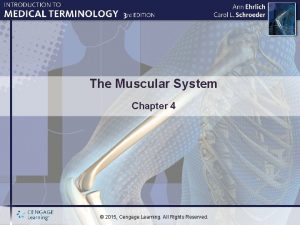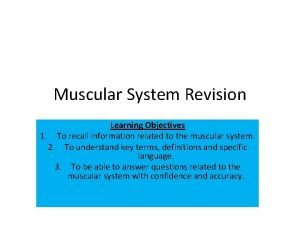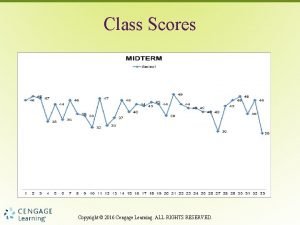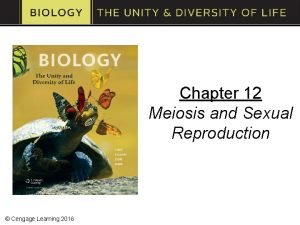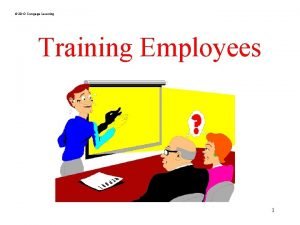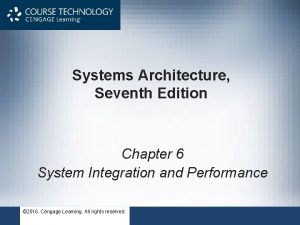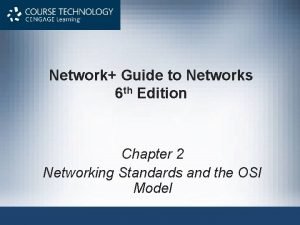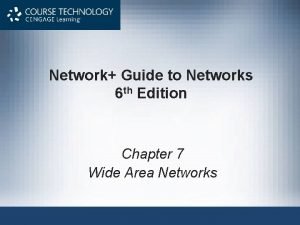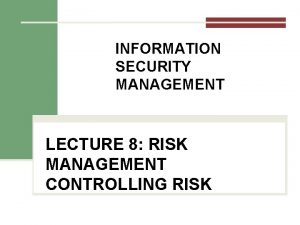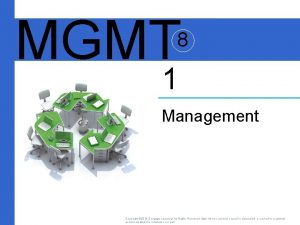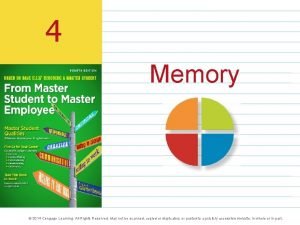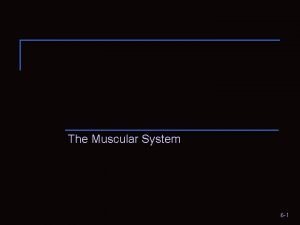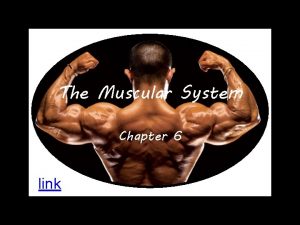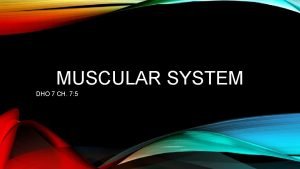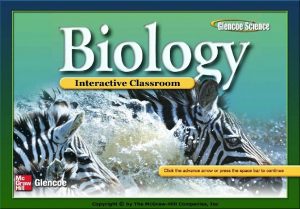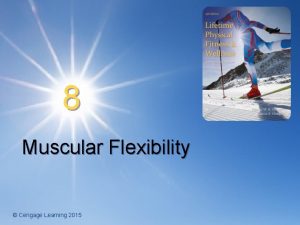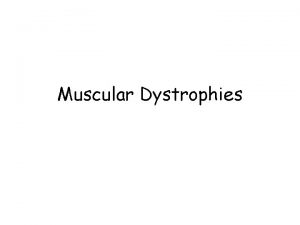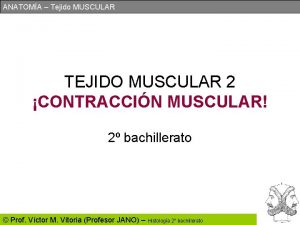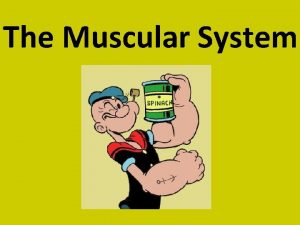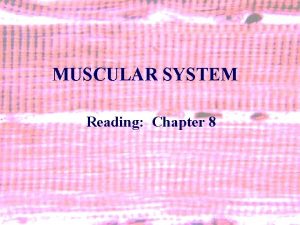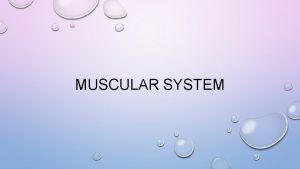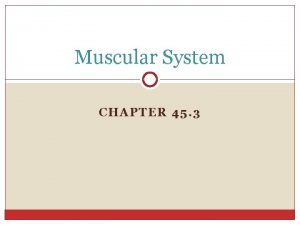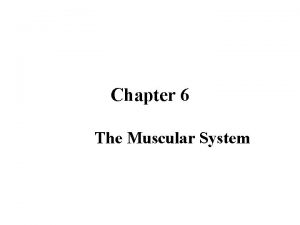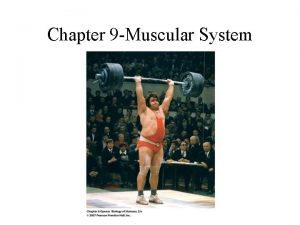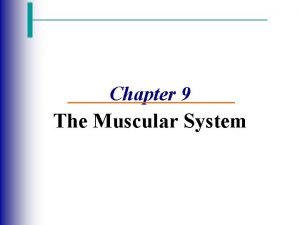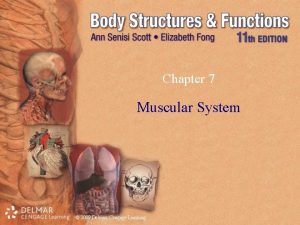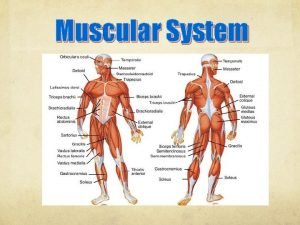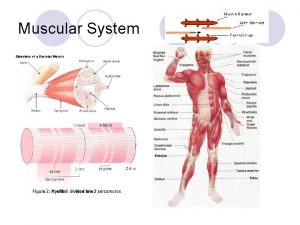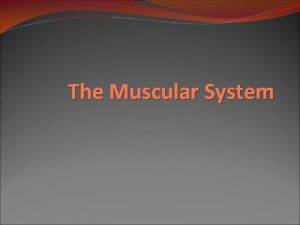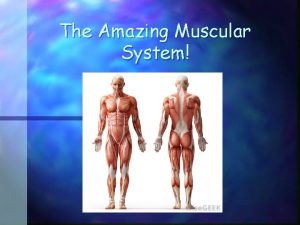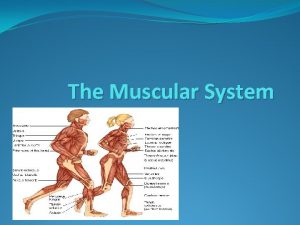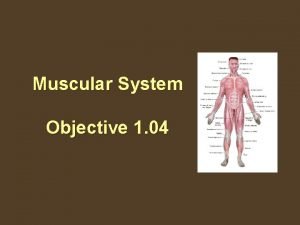The Muscular System Chapter 4 2015 Cengage Learning














































- Slides: 46

The Muscular System Chapter 4 © 2015, Cengage Learning. All Rights Reserved.

Overview of Structures, Combining Forms, and Functions of the Muscular System © 2015, Cengage Learning. All Rights Reserved.

Muscles • Primary Function – Make body movement possible – Hold body erect – Move body fluids – Produce body heat © 2015, Cengage Learning. All Rights Reserved.

Muscles • Related Word Parts (Combining Forms) – my/o, myos/o © 2015, Cengage Learning. All Rights Reserved.

Fascia • Primary Function – Cover, support, and separate muscles • Related Word Parts (Combining Forms) – fasci/o © 2015, Cengage Learning. All Rights Reserved.

Tendons • Primary Function – Attach muscles to bones • Related Word Parts (Combining Forms) – ten/o, tendin/o © 2015, Cengage Learning. All Rights Reserved.

Types of Muscle Tissue Skeletal muscles: • Attached to bones of the skeleton • Make body motions possible • Voluntary muscles • Striated muscles (continues) © 2015, Cengage Learning. All Rights Reserved.

© Cengage Learning Types of Muscle Tissue (continues) © 2015, Cengage Learning. All Rights Reserved.

Types of Muscle Tissue Smooth muscles: • Located in walls of internal organs, blood vessels, and ducts leading from glands • Move and control the flow of fluids through these structures • Involuntary, unstriated, and visceral muscles (continues) © 2015, Cengage Learning. All Rights Reserved.

© Cengage Learning Types of Muscle Tissue (continues) © 2015, Cengage Learning. All Rights Reserved.

Types of Muscle Tissue Myocardial Muscle • Form the muscular walls of the heart • Myocardium or cardiac muscle (continues) © 2015, Cengage Learning. All Rights Reserved.

© Cengage Learning Types of Muscle Tissue © 2015, Cengage Learning. All Rights Reserved.

Muscle Contraction and Relaxation • Muscle innervation: stimulation of a muscle by an impulse transmitted by a motor nerve • Neuromuscular: pertaining to the relationship between a nerve and muscle (continues) © 2015, Cengage Learning. All Rights Reserved.

Muscle Contraction and Relaxation • Antagonistic Muscle Pairs – Contraction – Relaxation © 2015, Cengage Learning. All Rights Reserved.

Contrasting Muscle Motion • Abduction: movement of a limb away from the midline of the body • Adduction: movement of a limb toward the midline of the body (continues) © 2015, Cengage Learning. All Rights Reserved.

© Cengage Learning Contrasting Muscle Motion © 2015, Cengage Learning. All Rights Reserved. (continues)

Contrasting Muscle Motion • Flexion: decreasing the angle between two bones by bending a limb at a joint • Extension: increasing the angle between two bones or the straightening out of a limb • Hyperextension: the extreme or overextension of a limb or body part beyond its normal limit (continues) © 2015, Cengage Learning. All Rights Reserved.

© Cengage Learning Contrasting Muscle Motion © 2015, Cengage Learning. All Rights Reserved.

Rotation and Circumduction • Rotation: a circular movement around an axis such as the shoulder joint • Circumduction: the circular movement at the far end of a limb (continues) © 2015, Cengage Learning. All Rights Reserved.

© Cengage Learning Rotation and Circumduction © 2015, Cengage Learning. All Rights Reserved.

Supination and Pronation • Supination: the act of rotating the arm or leg so that the palm of the hand or sole of the foot is turned forward or upward • Pronation: the act of rotating the arm or leg so that the palm of the hand or sole of the foot is turned downward or backward (continues) © 2015, Cengage Learning. All Rights Reserved.

© Cengage Learning Supination and Pronation © 2015, Cengage Learning. All Rights Reserved.

Dorsiflexion and Plantar Flexion • Dorsiflexion: the movement that bends the foot upward at the ankle • Plantar flexion: the movement that bends the foot downward at the ankle (continues) © 2015, Cengage Learning. All Rights Reserved.

© Cengage Learning Dorsiflexion and Plantar Flexion © 2015, Cengage Learning. All Rights Reserved.

Key Word Parts and Definitions • bi– twice, double, two • -cele – hernia, tumor, swelling • dys– bad, difficult, or painful • fasci/o – fascia, fibrous band (continues) © 2015, Cengage Learning. All Rights Reserved.

Key Word Parts and Definitions • fibr/o – fibrous tissue, fiber • -ia – abnormal condition, disease, plural of -ium • -ic – pertaining to • kines/o, kinesi/o – movement (continues) © 2015, Cengage Learning. All Rights Reserved.

Key Word Parts and Definitions • my/o – muscle • -plegia – paralysis, stroke • -rrhexis – rupture • tax/o – coordination, order (continues) © 2015, Cengage Learning. All Rights Reserved.

Key Word Parts and Definitions • ten/o, tendin/o – tendon, stretch out, extend, strain • ton/o – tone, stretching, tension, • tri– three © 2015, Cengage Learning. All Rights Reserved.

Questions © 2015, Cengage Learning. All Rights Reserved.

Question The largest muscle in the human body is found in the buttocks. True or False? © 2015, Cengage Learning. All Rights Reserved.

Answer True. The gluteus maximus in the buttocks is the largest muscle in the body. © 2015, Cengage Learning. All Rights Reserved.

Question How many muscles are required to raise your eyebrows? a. 15 b. 8 c. 30 © 2015, Cengage Learning. All Rights Reserved.

Answer c. 30 © 2015, Cengage Learning. All Rights Reserved.

Question Pronation is the act of rotating the arm so that the palm of the hand is turned upward. True or False? © 2015, Cengage Learning. All Rights Reserved.

Answer False. Supination is the act of rotating the arm so that the palm of the hand is turned upward. © 2015, Cengage Learning. All Rights Reserved.

Question Singultus is the medical term for: a. A facial tick b. Hiccups c. Cramps © 2015, Cengage Learning. All Rights Reserved.

Answer b. Hiccups © 2015, Cengage Learning. All Rights Reserved.

Answers to Learning Exercises © 2015, Cengage Learning. All Rights Reserved.

Chapter 4 Answers Matching Word Parts 1 4. 1. -ia 4. 2. fasci/o 4. 3. fibr/o 4. 4. -cele 4. 5. kines/o, kinesi/o 4. 6. tax/o 4. 7. my/o 4. 8. -rrhexis 4. 9. tend/o 4. 10. ton/o Matching Muscle Directions and Positions 4. 11. transverse 4. 12. sphincter 4. 13. oblique 4. 14. rectus 4. 15. lateralis © 2015, Cengage Learning. All Rights Reserved.

Chapter 4 Answers Definitions 4. 16. skeletal 4. 17. heel spur 4. 18. supination 4. 19. bradykinesia 4. 20. physiatrist 4. 21. myofascial 4. 22. tendon 4. 23. adhesion Definitions 4. 24. paraplegia 4. 25. tenodesis 4. 26. myocardial 4. 27. gluteus maximus 4. 28. tendon 4. 29. deltoid 4. 30. sphincter © 2015, Cengage Learning. All Rights Reserved.

Chapter 4 Answers Which Word? 4. 31. strain 4. 32. neuromuscular blocker 4. 33. dystonia 4. 34. impingement syndrome 4. 35. deltoid Spelling Counts 4. 36. antispasmodic 4. 37. singultus 4. 38. gravis 4. 39. ganglion 4. 40. pronation © 2015, Cengage Learning. All Rights Reserved.

Chapter 4 Answers Abbreviation Identification 4. 41. carpal tunnel syndrome 4. 42. deep tendon reflexes 4. 43. range of motion 4. 44. repetitive stress disorder 4. 45. spinal cord injury Term Selection 4. 46. myorrhexis 4. 47. myolysis 4. 48. hyperkinesia 4. 49. hamstring 4. 50. myofascial release © 2015, Cengage Learning. All Rights Reserved.

Chapter 4 Answers Sentence Completion 4. 51. epicondylitis 4. 52. flexion 4. 53. intermittent claudication 4. 54. myoparesis 4. 55. spasmodic torticollis Word Surgery 4. 56. electr/o, my/o, -graphy 4. 57. hyper-, kines, -ia 4. 58. my/o, clon, -us 4. 59. poly-, myos, -itis 4. 60. sarc/o, -penia © 2015, Cengage Learning. All Rights Reserved.

Chapter 4 Answers True/False 4. 61. True 4. 62. False 4. 63. True 4. 64. False 4. 65. False Clinical Conditions 4. 66. ganglion cyst 4. 67. myocele 4. 68. atrophy 4. 69. hypotonia 4. 70. chronic fatigue 4. 71. Achilles tendinitis 4. 72. myalgia 4. 73. shin splint 4. 74. quadriplegia 4. 75. hemiparesis © 2015, Cengage Learning. All Rights Reserved.

Chapter 4 Answers Which Is the Correct Medical Term? 4. 76. dystrophy 4. 77. carpal tunnel release 4. 78. adduction 4. 79. myotomy 4. 80. dorsiflexion Challenge Word Building 4. 81. myopathy 4. 82. polymyalgia 4. 83. myonecrosis 4. 84. fasciorrhaphy 4. 85. polymyectomy 4. 86. fasciodesis 4. 87. myocarditis 4. 88. fasciectomy 4. 89. herniorrhaphy 4. 90. sphincterotomy © 2015, Cengage Learning. All Rights Reserved.

Chapter 4 Answers Labeling Exercises 4. 91. flexion 4. 92. extension 4. 93. abduction 4. 94. adduction 4. 95. pronation 4. 96. supination 4. 97. dorsiflexion 4. 98. plantar flexion 4. 99. circumduction 4. 100. rotation © 2015, Cengage Learning. All Rights Reserved.
 Chapter 4 the muscular system labeling exercises
Chapter 4 the muscular system labeling exercises Chapter 13 medical math assignment sheet cengage learning
Chapter 13 medical math assignment sheet cengage learning Chapter 7 cengage
Chapter 7 cengage Plyometrics disadvantages
Plyometrics disadvantages Muscular system learning objectives
Muscular system learning objectives Chapter 6:2 interpreting word parts
Chapter 6:2 interpreting word parts Chapter 5 the cardiovascular system
Chapter 5 the cardiovascular system Cengage learning heart diagram
Cengage learning heart diagram South-western cengage learning
South-western cengage learning 2009 delmar cengage learning
2009 delmar cengage learning Cengage learning heart diagram
Cengage learning heart diagram Challenge word building medical terminology
Challenge word building medical terminology Cengage learning australia
Cengage learning australia 2009 delmar cengage learning
2009 delmar cengage learning Whille
Whille Cengage learning
Cengage learning Wadsworth cengage learning
Wadsworth cengage learning Cengage learning
Cengage learning Cengage learning plant cell
Cengage learning plant cell Cengage learning
Cengage learning Cengage learning
Cengage learning Brooks cole cengage learning
Brooks cole cengage learning 2014 cengage learning accounting answers
2014 cengage learning accounting answers Cengage chapter 7
Cengage chapter 7 Cengage learning
Cengage learning Cengage learning
Cengage learning 2009 delmar cengage learning
2009 delmar cengage learning Cengage learning
Cengage learning 2009 delmar cengage learning
2009 delmar cengage learning Cengage learning
Cengage learning 2012 cengage learning
2012 cengage learning Solomon four group design
Solomon four group design Cengage learning psychology
Cengage learning psychology Course technology cengage learning
Course technology cengage learning Course technology cengage learning
Course technology cengage learning Course technology cengage learning
Course technology cengage learning Course technology cengage learning
Course technology cengage learning Mgmt+8
Mgmt+8 Delmar cengage learning instructor resources
Delmar cengage learning instructor resources 2014 cengage learning
2014 cengage learning 2010 cengage learning
2010 cengage learning Muscular system figure
Muscular system figure The muscular system chapter 6
The muscular system chapter 6 Chapter 6 the muscular system figure 6-12
Chapter 6 the muscular system figure 6-12 Chapter 7:5 muscular system
Chapter 7:5 muscular system Chapter 9 muscular system
Chapter 9 muscular system Chapter 32 section 3 the muscular system
Chapter 32 section 3 the muscular system
